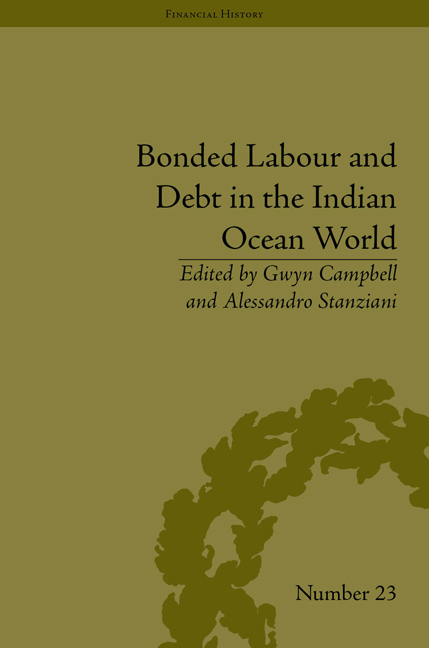Book contents
- Frontmatter
- Contents
- Acknowledgements
- List of Contributors
- Introduction
- 1 Debt and the Coercion of Labour in the Islamic Legal Tradition
- 2 Debt, Pawnship and Slavery in Nineteenth-Century East Africa
- 3 Debt and Slavery in Imperial Madagascar, 1790–1861
- 4 Credit and Debt in the Lives of Freed Slaves at the Cape of Good Hope: The Case of Arnoldus Koevoet, 1697–1735
- 5 Debt, Labour and Bondage: English Servants versus Indentured Immigrants in Mauritius, from the Late Eighteenth to Early Twentieth Century
- 6 Ransom, Escape and Debt Repayment in the Sulu Zone, 1750–1898
- 7 Debt and Slavery among Arabian Gulf Pearl Divers
- 8 The Political Economy of Debt Bondage in Contemporary South India
- 9 The Name of the Slave and the Quality of the Debt: When Slaves Are Not Debtors and Debtors Are Not Slaves in the Family Narrative of a Filipina Comfort Woman
- 10 Two Bonded Labour Emigration Patterns in Mid-Nineteenth-Century Southern China: The Coolie Trade and Emigration to Southeast Asia
- 11 Debt Slaves in Old Korea
- 12 The Debt-Servitude of Prostitutes in Japan during the Edo Period, 1600–1868
- Notes
- Index
1 - Debt and the Coercion of Labour in the Islamic Legal Tradition
- Frontmatter
- Contents
- Acknowledgements
- List of Contributors
- Introduction
- 1 Debt and the Coercion of Labour in the Islamic Legal Tradition
- 2 Debt, Pawnship and Slavery in Nineteenth-Century East Africa
- 3 Debt and Slavery in Imperial Madagascar, 1790–1861
- 4 Credit and Debt in the Lives of Freed Slaves at the Cape of Good Hope: The Case of Arnoldus Koevoet, 1697–1735
- 5 Debt, Labour and Bondage: English Servants versus Indentured Immigrants in Mauritius, from the Late Eighteenth to Early Twentieth Century
- 6 Ransom, Escape and Debt Repayment in the Sulu Zone, 1750–1898
- 7 Debt and Slavery among Arabian Gulf Pearl Divers
- 8 The Political Economy of Debt Bondage in Contemporary South India
- 9 The Name of the Slave and the Quality of the Debt: When Slaves Are Not Debtors and Debtors Are Not Slaves in the Family Narrative of a Filipina Comfort Woman
- 10 Two Bonded Labour Emigration Patterns in Mid-Nineteenth-Century Southern China: The Coolie Trade and Emigration to Southeast Asia
- 11 Debt Slaves in Old Korea
- 12 The Debt-Servitude of Prostitutes in Japan during the Edo Period, 1600–1868
- Notes
- Index
Summary
Introduction: Enslavement and Debt in Islam
Enslavement was the only acceptable form of coercion of labour in the Islamic legal tradition, and this held to a considerable degree in practice. Chattel servitude was permitted and regulated by the Qur' an, hadith (tradition), Prophetic biographies, and the huge body of exegetical legal texts. The religious legitimacy of slavery was only gradually challenged from the 1870s, as Islamic abolitionism began to develop. At the same time, the ulama consistently taught that there was no sanction in the holy texts for bonded or coerced labour of any type other than slavery.
This religious view of the matter did not always prevail, especially under powerful rulers, who might pay little heed to the law of God. Thus, the Mamluk sultans of Egypt and Syria, who wore their religion rather lightly, employed much forced labour for construction and other purposes. Similarly, the Ottoman sultans press-ganged or conscripted men to supplement slave rowers on Mediterranean galleys, together with some convicts. Muhammad 'Alî was notorious for the extent to which he imposed corvée labour across Egypt in the early nineteenth century. However, Egyptians denounced this kind of forced labour (sukhra) as illegitimate ‘tyranny’
Religious syncretism might result in forms of labour mobilization other than slavery. The Circassians of the north-western Caucasus were famed alike for their superfi cial Islam and for their harsh system of serfdom, which coexisted with slavery proper.
- Type
- Chapter
- Information
- Bonded Labour and Debt in the Indian Ocean World , pp. 21 - 30Publisher: Pickering & ChattoFirst published in: 2014



